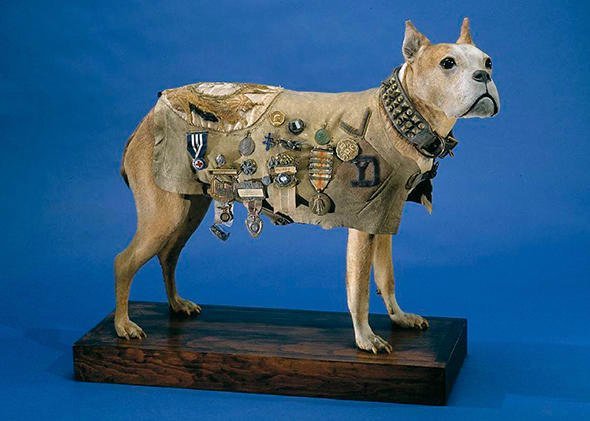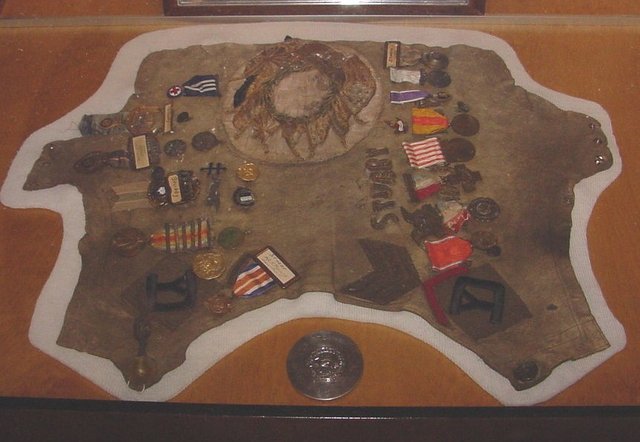
From homeless to hero he learned bugle calls, saved lives, took part in 17 battles, and even captured a German soldier!

Private Robert Conroy was a young man undergoing army training on the fields of Yale University in 1917 when a young stray dog strolled onto the yard (possibly a bull terrier mix). He decided to take the stray puppy into his care and named him Stubby after his short tail.
The only problem was that pets were not allowed, however the dog was well liked by the troops and if any superior officer knew of the dog he must have looked the other way. Stubby became the unofficial mascot of the 102nd Infantry Battalion and soon learned the different bugle calls, marches, and even how to salute by raising his right paw to above his eye.
When the time came for the unit to ship off to France, Private Conroy smuggled Stubby inside his rolled up Army-issued greatcoat to get past the ship guards and put him into a coal bin until they had left port. When they were well out to sea, Conroy went to fetch Stubby out of the bin and when the other soldiers saw Stubby they cheered.
The commander, an intimidating man named Colonel John “Machinegun” Parker, soon found out about the stowaway dog and was displeased since the animal was not allowed per regulations. The ever astute Stubby realized that he was in trouble and promptly gave the commander a salute. This impressed the officer so much that he allowed Stubby to stay for morale purposes. It was later said that Stubby was the only member of the regiment that could talk back to Col Parker and get away with it. During the journey over, a machinist onboard the ship made a set of dog tags for Stubby.

After training with experienced French forces from October 1917 to February, the 102nd Infantry was sent to the front lines where they were to see more fighting than any other American infantry division – a total of 210 days.
Stubby learned the difference between the Khaki doughboy uniforms and the gray German ones, and whether someone was speaking English or German. He would run out into no man’s land to find wounded friendly troops and bark to guide medics to the injured man. Stubby would also whine when he heard incoming artillery shells well before a human could pick up the sound.
The first injury Stubby sustained was from a mustard gas attack, for which he was sent to the field hospital and made a complete recovery. This sensitized him to the smell of the gas and later during a pre-dawn gas attack Stubby ran up and down the allied trenches barking and waking up sleeping men. On April 5th, for this act, he was given his first military rank of private first class (the first dog to ever be given a military rank).

Later in the month, during the battle of Seicheprey of April 20th in which 3,000 Germans attacked 600 Americans, Stubby was wounded in the chest and left foreleg by an exploding grenade. Sent back to the hospital, he underwent surgery to remove the shrapnel and made another full recovery. While in the hospital he boosted the morale of everyone.
Grateful ladies of the nearby Chateau Thierry made a custom doggy uniform for him, which had his rank, name, flags of the allies, and later on his numerous medals.
Back with his regiment, he sniffed out a German soldier spying and mapping out the allied trenches. Stubby chased after the man, attacking his legs causing him to fall and then keeping him down, which allowed friendly soldiers to take the new German prisoner into custody. For this act, Stubby claimed the man’s Iron Cross medal (which was pinned to his uniform) and was promoted to Sergeant.
After the war, Stubby again had to be smuggled as there was no allowance for dogs onboard – but I am sure any officers just looked the other way. When he hit land in the United States, Stubby’s war exploits were printed in the papers nationwide and he became a celebrity.

Stubby was given lifetime memberships in the American Legion, Red Cross, and YMCA. He met three presidents – Wilson, Harding, and Coolidge. He would perform in vaudeville shows and be paid $62.50 for three days of performance, which was over twice the weekly salary of the average person. Even the Grand Hotel Majestic in NYC lifted its ban on dogs so Sergeant Stubby could stay there.
Sergeant Stubby at the Smithsonian Institution National Museum of American History
Robert Conroy, Stubby’s master, went on to study law at Georgetown University and Stubby became the school’s mascot. During halftime he would go onto the field and move the football with his snout, a huge hit with the crowds and some say the catalyst for halftime shows to begin. He is the reason that the university has a bulldog as a mascot today.

Stubby died of natural causes in the arms of Conroy in 1926. You can read the New York Times obituary here. His body was taxidermied and is still on display at the Smithsonian. A Disney animated film of his life was released in the spring of 2018.

On the left side of his uniform you can see the following medals and accouterments:
- 3 Service Stripes
- Yankee Division YD Patch
- French Medal Battle of Verdun
- 1st Annual American Legion Convention Medal Minneapolis, Minnesota Nov 1919
- New Haven WW1 Veterans Medal
- Republic of France Grande War Medal
- St Mihiel Campaign Medal
- Purple Heart
- Chateau Thierry Campaign Medal
- 6th Annual American Legion Convention

Sources:
- Stubby the Military Dog
- Sergeant Stubby
- Sergeant Stubby
- Pictures: 1 2
In honor of Veterans Day, this is a repost from a few years back.
Never heard of this Story and the dog. Very interesting. Thanks for sharing @getonthetrain ;)
Downvoting a post can decrease pending rewards and make it less visible. Common reasons:
Submit
Wow, I had no clue! That's so cool that he picked up on things so quickly, and that the reason he was allowed to stay was because he learned to salute and show respect to commanding officers.
I laughed when I read about him tackling the enemy solider and then getting the guy's medal. He sounds like a very heroic dog. I enjoyed getting to learn a little about his life.
Downvoting a post can decrease pending rewards and make it less visible. Common reasons:
Submit
@getonthetrain General Pershing No Less.........
Downvoting a post can decrease pending rewards and make it less visible. Common reasons:
Submit
That was a cool ass story.
Downvoting a post can decrease pending rewards and make it less visible. Common reasons:
Submit
Hola!
I see that you like history a lot. You should have come to SF 3.
We visited Auschwitz.
Downvoting a post can decrease pending rewards and make it less visible. Common reasons:
Submit
Oh I wish I was able to get over there this year. SF is amazing and we coulda chatted some more.
Downvoting a post can decrease pending rewards and make it less visible. Common reasons:
Submit